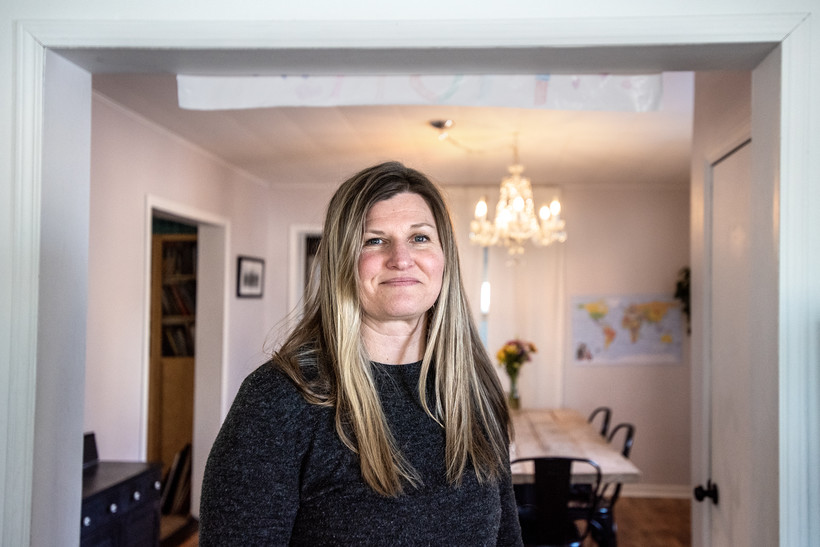Remote Work Proves Durable in Wisconsin
400,000 in state, or 15% of workforce, now work remotely.

Laura Isaacson works remotely for a San Francisco-based company on Friday, Feb. 17, 2023, from her home in Mount Horeb, Wis. Angela Major/WPR
On a sunny Friday afternoon, Laura Isaacson is petting her chocolate lab Bea. She sits back at her office desk, a makeshift spot at a dining table. Surrounding her are bookshelves, wide windows and a view of sprawling grass in Mount Horeb.
“I am so much happier right now,” she said. “I don’t think I even realized before how stressed out I was trying to balance being a mom and working full time outside of the house.”
Isaacson is one of more than 400,000 remote workers in Wisconsin. Three years after the COVID-19 pandemic supercharged the shift to remote work, especially among office workers, she is one of those for whom the change appears to be permanent.

Laura Isaacson pets one of her four dogs, a chocolate lab named Bea, while taking a break working remotely for a San Francisco-based company on Friday, Feb. 17, 2023, from her home in Mount Horeb, Wis. Angela Major/WPR
Nationally, the number of people working from home between 2019 and 2021 tripled from 5.7 percent to 17.9 percent, according to estimates from the U.S. Census Bureau.
More recently, though, there are signs that the number of people working from home is slightly declining, in Wisconsin and nationally. A Morning Consult poll in April found nearly half of U.S. employees prefer working in-person. But attempts to bring workers back to the office also face challenges, and at least some companies are planning to keep hybrid or work-from-home options around indefinitely.
In Wisconsin, remote work could make the relatively low-cost state more competitive as people with higher incomes boost rural areas, experts say. But some worry that with people working for companies outside the state, local services that might benefit from their expertise could lose out.
Jose Maria Barrero, a co-founder of the Work From Home research project, or WFH Research, said the increase in personal benefits, autonomy and flexibility is a net positive for the broader economy.
Some like Isaacson are fully remote, but a majority of workers, nationally, are fully in-person — about 60 percent, according to WFH Research. That’s in part because most people are employed in sectors such as manufacturing and services, which cannot always be done through a computer screen. Yet for many workers across many industries, there has been a substantial shift to a hybrid working mode, where about 28 percent of workers work remotely some of the time.
Isaacson, who had her hours reduced by her hospital at the onset of the pandemic in March 2020, said remote work opportunities for dietitians turned out to be abundant. Telehealth demands exploded. She began working remotely to supplement the lost income with her reduced hours at the hospital, and soon made it her full-time job.
Without a commute, Isaacson exercises and spends more time with her kids. She can sit by the window in the comfort of her home. And without the daily distractions of a busy hospital, she can focus in a quieter setting. She said she’s more productive.
Then there’s letting go of guilt. Sometimes her kids were the last to be picked up from day care.
“I would come home and feel like the worst mom,” she said.

Rachael Bergstrom stands in her Mineral Point home where she works from an upstairs office Friday, Feb. 17, 2023, in Mineral Point, Wis. Angela Major/WPR
Working from home can blur work-life boundaries
In Wisconsin, decades-long efforts to expand high-speed internet to rural areas has helped make remote work possible for some workers. On a bucolic sheep farm in Mineral Point, Rachael Bergstrom speaks with a client on Zoom for her educational consulting job for the Texas-based firm Maya Consulting.
Only just five years ago, it would have been inconceivable.
“Our Wi-Fi would not have been stable enough to run,” Bergstrom said. “The technological advancements are really what’s made it possible.”
In recent years, millions of federal and state dollars have gone to expanding broadband access, ushering in a new era of connectivity for urban and rural communities.
In his most recent budget proposal, Evers pledged to invest $750 million into broadband access. Last week, Republican state lawmakers voted to eliminate that plan, saying Wisconsin would wait for an upcoming influx of federal broadband funding instead.
The high-speed internet infrastructure that now reaches more than 93 percent of Wisconsin’s population is what made it possible for many jobs to be done remotely.
For Bergstrom, remote work meant an end to years of leaving her home at 5 a.m. to catch a ride on the state vanpool to Madison. She worked for the Wisconsin Department of Public Instruction. In all, she spent some three hours on the road.
“I don’t know that I coped with the commute,” she said. “I think it took a bigger toll on me than I realize now that I have more time to think and take my kids to school in the morning.”
Working from home, she said, has only strengthened her ties to her community. Without a commute, she’s less drained at the end of the day. She has more time to stop at a local coffee shop for a quick bite. And she connects with other parents when they pick up kids from school.
Still, there are some caveats. Both Bergstrom and Isaacson agreed it can be hard to shut off — when work and home are the same place, the boundaries between work time and personal time can become blurred.

Rachael Bergstrom, right, speaks to her children Eli, left, and Ollie, center, after participating in a meeting from her home office Friday, Feb. 17, 2023, in Mineral Point, Wis. Angela Major/WPR
Remote work varies across different counties in Wisconsin
Remote work is less common in Wisconsin than in other states, but it varies by county, according to a recent Wisconsin Policy Forum report. In 2021, 14.8 percent of workers statewide primarily worked from home, compared to 17.9 percent of workers nationally.
That year, Dane County led the state with the most remote workers at 24.4 percent of all county residents. In suburban Milwaukee, Ozaukee County had a 21 percent share of remote workers, followed by 19.6 percent in Waukesha County.
Yet in Manitowoc County, only 9.5 percent of residents worked remotely, followed by 8.3 percent in Rock County and 7 percent in Dodge County. Those three counties had the highest share of in-person workers in the manufacturing sector.
And the remote-work equilibrium may be changing again.
A Pew Research survey in March found that 41 percent of people who work remotely are working a hybrid schedule, or splitting their time working from home and going to the office, a workplace or job site. That’s up from 35 percent in January 2022.
And Barrero said research shows people get more mentorship through in-person work, one example of a potential drawback.
Of those who work from home, 36 percent say it hurts their opportunities to be mentored, compared to 10 percent who say it helps, the Pew survey found.
According to the Wisconsin Policy Forum report, Madison ranked 22nd among the nation’s 100 largest metropolitan areas nationally for the share of remote workers (22.6 percent) in 2021. Milwaukee, at 17.9 percent, was 45th for the share of remote workers in 2021.
In July and August of 2021, 24.7 percent of Wisconsin survey respondents said someone in their household worked remotely in the last seven days. In January 2023, that fell just slightly to 23.9 percent, something that surprised Wisconsin Policy Forum researcher Mark Sommerhauser. He said that decline is not particularly significant but could be explained, in part, because some are now working hybrid.
“Remote work, at least so far, has been very durable,” he said.
Sommerhauser said central business districts and downtown areas home to plenty of real estate are nowhere near back to pre-pandemic levels of occupancy, but those effects are only just starting to be seen.
A recent study by the School of Cities titled “The Death of Downtown?” found Milwaukee was at about 71 percent of pre-pandemic activity in its downtown. And in 10 of the largest U.S. cities, the average office occupancy rate was 50 percent at the end of January, according to a report from Kastle Systems.

Rachael Bergstrom participates in a Zoom meeting from her home office Friday, Feb. 17, 2023, in Mineral Point, Wis. Angela Major/WPR
Is Wisconsin a winner in the work-from-home economy?
Barrero of WFH Research said that broadly speaking, a state like Wisconsin can benefit from retaining workers who find remote jobs at corporations outside of the state. That’s in part because the relatively low cost-of-living in Wisconsin could make it an attractive place to live while working remotely outside the state.
“I think you can definitely be a winner if you are a low-cost state,” Barrero said, though it depends on housing costs and regulations around employment and contract work.
In some ways, a company like Isaacson’s in the Bay Area could be more productive if it makes a strong remote hire, Barrero said. And it could benefit the state if that employee pays high state income taxes and spends more dollars locally.
“This new world of remote work has enabled greater competition than there used to be,” he said.
Barrero said the shift will likely mean a change in opportunity for different locations. Some coffee shops and retail stores in downtown areas catered to office workers may move their services to residential areas and suburbs. And he said it could change the property sector for the same reason.
Wisconsin relies heavily on property taxes. And with less foot traffic and money spent in downtown areas, lawmakers will have to grapple with different ways to recover lost tax revenue, Barrero said.
Barrero said it’s possible that raising income or property taxes could help, but it may also deter remote workers from choosing to live in Wisconsin.
“Wisconsin is interesting in that it is a state that has both large urban areas and a lot of rural areas,” he said. “I think it has an opportunity to perhaps decongest the congested parts of the state.”
That’s already true in Mount Horeb, where Isaacson said she’s in no rush to leave. And in Mineral Point, Bergstrom said she doesn’t know what the future holds, but she hopes remote work could benefit small towns like hers.
“Maybe kids will stay in their small towns more because they can find a job programming, or they can find a job in an industry that’s really booming, even if there’s not a huge company here that does that,” she said.
Listen to the WPR report here.
Despite some calls by companies to return workers to offices, remote work is proving durable in Wisconsin was originally published by Wisconsin Public Radio.





















